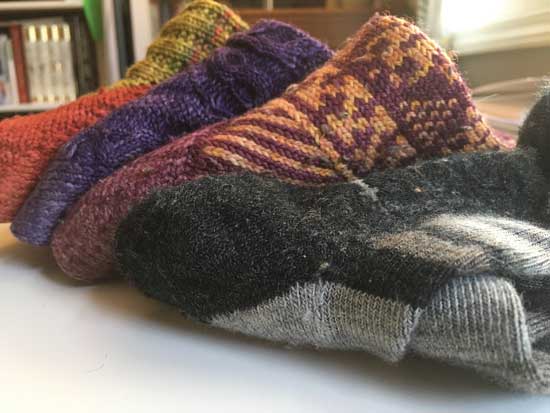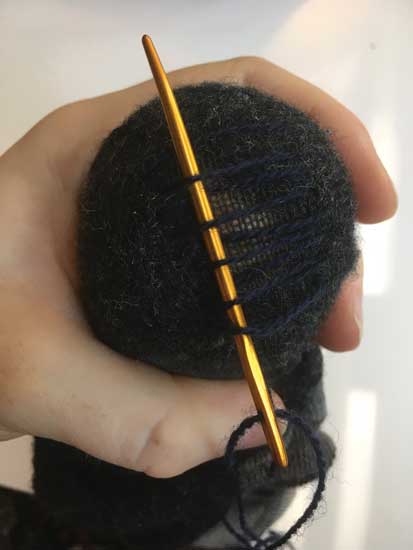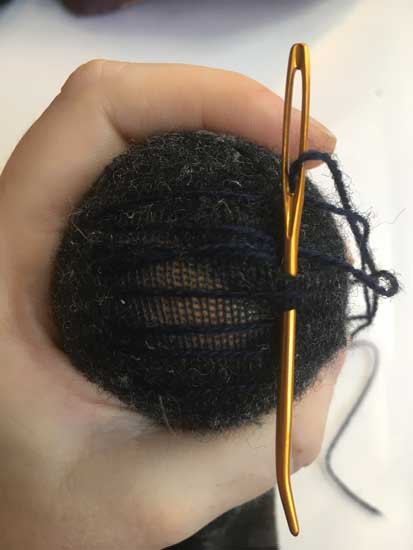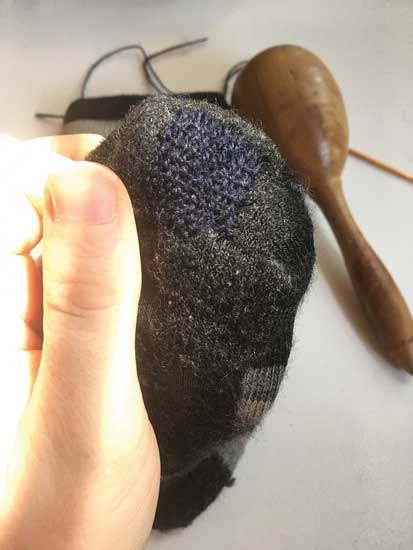Basic Running Stitch Darn
Darning is a particular type of cloth mending where you use a needle to weave a little patch of new fabric directly onto the torn garment. You can make a nearly invisible darn if you happen to have the same yarn or thread the cloth was made from, or if you can find something that matches.

Photo by Caitlin Wilson.
Historically, invisible darns were preferred around the world; in India and Kashmir, professional darners made repairs to treasured garments with threads carefully pulled from the seam allowances and hems. When heavy taxation threatened to put Kashmir weavers out of business, they began weaving half-sized shawls, which merited lower taxes. Kashmiri darners would then join the halves into a single, full-sized shawl, often making the join so perfectly that it couldn’t be seen with the naked eye. Nowadays, visible mending is becoming more popular, and some textile artists use bright colors and flashy patterns to draw attention to their darns.
Darning Tools
As with many mending techniques, neither the tools nor the skills you’ll need are difficult to acquire. A needle, thread or yarn, and scissors are the only essential tools, and if you can work a running stitch, you can darn. A few other tools will make your job easier too.
Most craft stores sell special darning needles, which may have angled or slightly flattened tips to allow them to pass through fabric more easily. The idea isn’t to stab the needle through the threads of the existing fabric, but rather to pass through the spaces between the threads. Modern darning needles are designed mainly for hand knitters working with heavier yarn; if you plan to darn lightweight fabrics with thread, you might want to use a long sewing needle or a beading needle instead.
You’ll need to choose the color and weight of your darning thread according to the effect you want. Color-wise, the sky’s the limit for visible darns! You can choose a single contrasting color, or a rainbow of shades. For an invisible darn, find matching thread; if you can’t find an exact match, a slightly darker shade will blend better than a lighter shade. The most invisible darns are made by pulling threads from the seam allowances, hems, or scrap pieces of matching fabric. This last technique is easiest on handmade garments, which tend to have larger and more accessible seam allowances than store-bought clothes. In all cases, choose thread or yarn of a similar thickness and fiber content as the garment you plan to darn. The darn will feel and wear better if it matches the original fabric. A bulky darn on a fine fabric looks clunky, and a delicate darn on heavier fabric won’t do its job for long; neither outcome is desirable.
For scissors, any sort that cut cleanly will do. Darning mostly requires cutting thread and trimming rough edges on the torn fabric, so you don’t need special sewing scissors.
That’s all you really need to darn. Optional tools are a thimble and a darning egg or mushroom. I don’t often work with a thimble, but they can be handy, especially if you’re working with fine thread and a sharp needle.
Darning eggs and mushrooms are slightly different shapes, but they serve the same purpose. They’re used to stretch the fabric at the toes and heels of worn socks into the correct shape; while knitted fabric is stretchy, darning makes a patch of woven fabric, so it needs to be done over something that imitates the shape of a foot inside the sock.
Darning eggs look like, well, eggs, and are most often made of wood, though ceramic, stone, and even silver darning eggs also exist. Some darning eggs have a protruding handle for the darner to hold while they work. Darning mushrooms look like broad-capped mushrooms, with the stem serving as the handle.
Many other rounded, smooth-surfaced objects would work as substitute darning eggs. Dried, shellacked gourds work well, and come with built-in handles; see “Gritty’s Tips” for more details about growing and harvesting your own. Some folks might remember learning on burnt-out lightbulbs — they’re the right shape, but there’s a chance the bulb could break. I recommend choosing a sturdier item. Even a smooth river rock, fist-sized or a little smaller, would make a fine darning egg in a pinch.
Basic Running Stitch Darn
This is the simplest and most-used darn in my mending toolkit, and I’ve worked it in everything from sewing thread to lush knitting yarn. Essentially, you weave a tiny patch in place on the torn garment. If you’re mending socks, remember to stretch them over a darning egg so your darn ends up the right size for the foot that goes into the sock. Just keep woven garments flat while you work to avoid puckering the fabric.
Photos by Caitlin Wilson

For a variation on the basic darn, try working different woven patterns into your darn. A basic twill weave (the structure that makes denim) is composed of staggered rows of an over-1, under-3 pattern. If you play with the basic pattern, you can get zigzags and diamonds pretty easily — a dramatic look for a visible darn, or a subtle detail in a nearly invisible one.
GRIT, USA

PROFILE
GRIT is a bi-monthly magazine distributed throughout the United States and Canada that celebrates country lifestyles of all kinds, while emphasizing the importance of community and stewardship.
GRIT offers practical advice, product reviews, livestock guides, gardening, cooking and other do-it-yourself information, humor and the inspirational stories of folks who moved to the country and love it.




